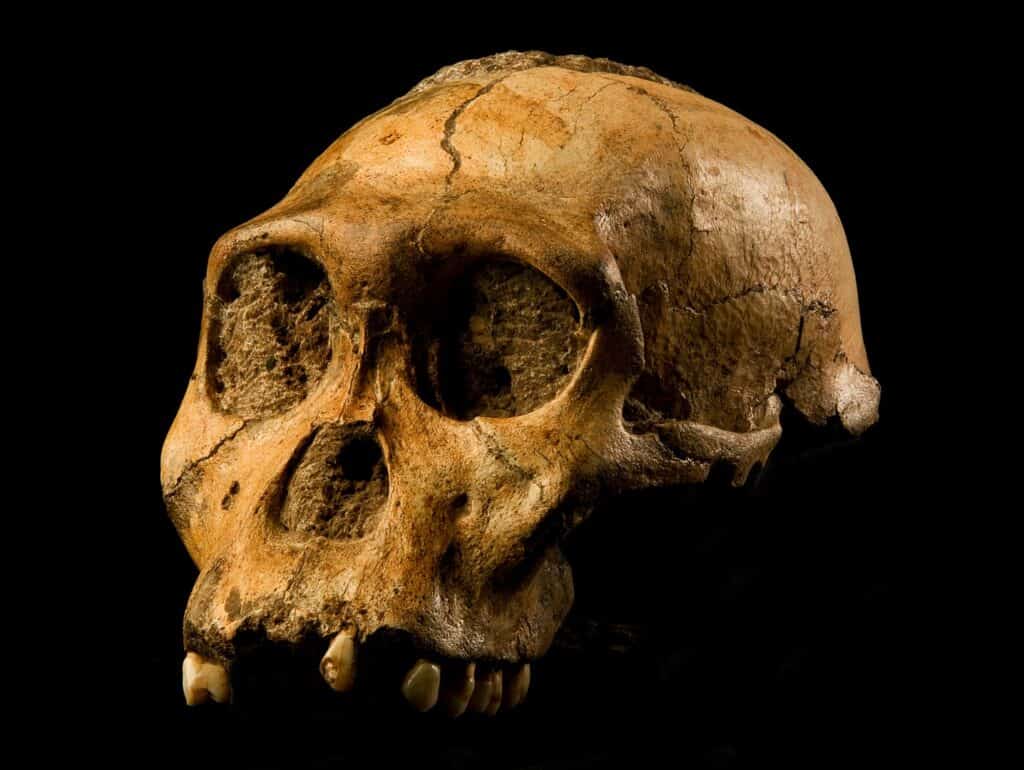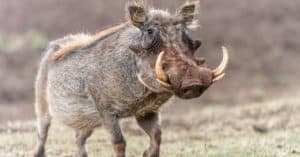Have you wondered just how humans could have ever been related to primates? The answer is simple – adapt or die. When faced with constant environmental changes that affect food sources, habitat, or even the flow of a river, every animal has to find a way to cope with these changes or face extinction. Some creatures are better able to cope with these changes and find ways to adapt. Others also find ways to make their environment adapt to them. This is what our ancestors did and what we do on a massive scale today – we make the world adapt to us.
Also known as the southern ape, Australopithecus is a group of primates. These extinct animals have been identified from fossils discovered in Africa. Scientists suggest that the Australopithecus primates are the close relatives or ancestors of humans. Many species of this primate group thrived during two epochs — the Pliocene and the Pleistocene. The most famous specimen of these primates is Lucy.
What are the different characteristics and species of this ancient animal? Let us review the following information and understand how close it is to humans.
Everything to Know About Australopithecus
The name of this genus means southern ape. It is an extinct group of early humans. Scientists have classified the Australopithecus as a hominid genus. They belong to the Hominidae family. Australopithecus appeared and evolved before the genus Homo.
The features of this hominid were a combination of apelike and human-like. Their arms were longer. Scientists believe that this was for climbing. Their brains were smaller than a human’s. They were more like those of modern apes. They appeared more apelike, with jutting jaws and sloping faces.
Skeletal evidence shows that these hominids walked upright. The teeth of some Australopithecus species were human-like. This showed that human ancestors learned to walk upright even before their brains grew larger. Their back teeth were bigger than those in modern humans and their canines were smaller than those in apes.
Pre-Australopithecus
Knowing which is the earliest member of the Hominin is challenging. This is because the ancestors of modern humans were apelike. Fossil records showed that the first humans had human and ape characteristics. Some scientists named the first human species to be Sahelanthropus tchadensis. This species had a face that did not protrude that far and small canines. The brain size was more like that of an ape. The scientists did not confirm if this species walked upright or not.
Walking upright or bipedalism was evident in Orrorin tugenensis. The remains of this species were found in Central Kenya. Scientists described this as the earliest hominin. It had thick enamel around its molars. Its premolars and canines were apelike. Its femur was human-like. This was evidence that this species walked upright.
Ardipithecus kadabba walked upright. Research suggests that its brain and body size were similar to that of a chimpanzee. Its canines were like those of later hominins but still protrude. This hominin ate fibrous foods instead of soft leaves and fruit like the chimpanzees. This was evident through the larger back teeth. Its front teeth were narrower. This type of teeth focused on chewing difficult foods like fibrous vegetables and nuts.
Ardipithecus ramidus was named Ardi by scientists. This hominin had one large toe for each rigid foot. Fossil reconstruction showed that its feet were used for walking and tree-climbing. Ardi did not resemble a chimpanzee. This hominin’s fossils were found in a wooded area. This goes against the theory that bipedalism started in the savanna.
Ardi seemed to be an omnivore. This hominin liked to eat fruits, plants, and meat. Abrasive and hard foods were not part of Ardi’s diet. Evidence of this is in the enamel, which was neither thin nor thick.
Australopithecus anamensis
Australopithecus anamensis had human and ape traits. The upper part of the tibia was expanded. The ankle bone’s orientation indicated walking on two legs. Specialized wrist features and long arms showed evidence of climbing. This species had a protruding face. Its braincase was narrow. They had a thick enamel.
Australopithecus afarensis and Australopithecus garhi
There are at least 400 fossil specimens representing Australopithecus afarensis. This species had human-like and apelike features. The snout, dentition, and dental arch look like that of an ape. The cranial capacity is one-third of a modern human.
Australopithecus afarensis walked on two feet. Their ankle, hip, pelvis, and knee were similar to those of modern humans. This species has curved toes and fingers were reminders of their apelike ancestors. The upper limb is longer than the lower limb. The spine of this species had curvatures similar to a human spine. Australopithecus garhi has some traits in common with Australopithecus afarensis. But the cheek teeth were larger. There was also a crest that ran along the braincase’s midline.

©By Cicero Moraes – Own work, CC BY-SA 4.0, https://commons.wikimedia.org/w/index.php?curid=23804678
Australopithecus africanus
Many specimens of this species have been unearthed. One was a child in Africa. Other specimens came from Makapansgat, South Africa. A common characteristic in these remains is the absence of stone tools. Cheek teeth are expanded and the jaw size increased. There were other changes to the skull that helped in chewing challenging pieces of food.
Lucy
Lucy was the name given to one of the very first unearthed hominin fossils. She became a famous name. Scientists were able to find 40% of her whole body. Back then, she was the most complete early hominin that was discovered. It took weeks of excavation to unearth 47 bones out of the supposed 207. Most of the foot and hand bones were missing.
The pelvic bone’s shape showed that Lucy was a female. She was 1.05 meters in height. She weighed about 28 kilograms. Some of the bones were fused and there was an erupted wisdom tooth. This showed that Lucy was a young adult.
The reason for Lucy’s death was a fall from a great height. This was evident in the CT scans of her arms and shoulder joint. It was as if Lucy reached out to somehow stop her fall. The bone breakages were all before her death and not as the bones deteriorated and fossilized. Researchers also add that the injuries were bad enough that Lucy’s internal organs could also have experienced trauma. Experts concluded that Lucy died falling from a tall tree. Some scientists believe that Lucy could have been trampled by stampeding herd animals after she died.
Australopithecus sediba
The very first specimen for this species was a collarbone and jawbone of a young male hominin. The scientists unearthed it in the Malapa Caves of South Africa. They recovered two incomplete hominin skeletons. Complete hand and arm skeletons belonged to an adult female. The cranium belonged to a young male.
Evidence shows that Australopithecus sediba is a direct descendant of the Australopithecus africanus. The specimens were a combination of apelike and human-like traits. The thumb of the adult female indicated that the Australopithecus sediba may have used simple or stone tools. Evidence also shows that this species might be the earliest ancestor of modern humans.

©By Photo by Brett Eloff. Courtesy Profberger and Wits University who release it under the terms below. – Own work, CC BY-SA 4.0, https://commons.wikimedia.org/w/index.php?curid=10094681 – License
Australopithecus aethiopicus
This species used to be called Paranthropus aethopicus. It is the earliest of all robust australopiths. Robust means having extremely large cheek teeth, a thick mandible, and a crested cranium. These species are classified as Paranthropus.
This species of Australopithecus exhibited powerful chewing abilities. One fossil found in the Omo River of Ethiopia showed that these early humans were well-adapted to eating hard and tough food. The specimen was called Black Skull. This fossil had very large premolars and molars. It also has a bladelike sagittal crest, thick palate, and massive cheekbones. It had large front teeth and a protruding lower face.
Australopithecus boisei and Australopithecus robustus
These species of Australopithecus are known for their robustness. Their temporal muscle was attached to their fully developed skull crest. This feature, combined with massive cheek teeth, powerful cheekbones, and thick jaws, allowed them to chew tough food items. These exaggerated chewing traits made their heads very different from modern human heads. Australopithecus boisei was classified as hyper-robust.
Scientists suggest that this genus lived at the same time as the genus Homo. Even so, they lived in different habitats. The body of a robust Australopithecus was small, but its brain was larger than that of the Australopithecus africanus. Their fossils were found with mammals that lived in dry grasslands. This proved that the robust Australopithecus were grass eaters.
The Changes in the Anatomy of Australopithecus
Bipedalism in Australopithecus means that their hands were not used for locomotive activities anymore. This separated the hominins from the apes. Even so, scientists are still wondering about the advantages that bipedalism brought Australopithecus. Recent studies show that it may be because of the following:
- Freeing their hands might have allowed them to carry more food.
- It was a more efficient way to use energy.
- Standing on two feet allowed them to look above tall grass for predators or dangers.
- It changed how predators saw them.
- It was an advantage when scavenging for food.
- Standing upright helps release more body heat.
- Being on two feet also reduces the skin’s exposure to ultraviolet light.
- The hands are free to use different types of tools.
- It made carrying and caring for babies easier.
The advantages of bipedalism paved the way for the evolution of Homo sapiens. Bipedal Australopithecus are the ancestors of modern man. Even so, consequences formed from this two-legged locomotion. The hominins became clumsier and more prone to conditions, such as lower back pain.
Conclusion
Australopithecus is the bipedal ancestor of modern man. Evidence shows that these early hominins developed walking on two feet because of necessity. Survival and strategy developed in this species as well. Understanding the origins of modern man can help you appreciate how far humans have gone in their anatomical, mental, and physiological evolution.
Up Next…
- When Did Dinosaurs Go Extinct? The extinction of dinosaurs left room for other animals to develop, including humans. Learn more about how this happened here.
- The 7 Best Books about Evolution to Boost Your Understanding Do you want to learn more about human evolution? Check out these books.
- Watch A Chimp Hit Evolution Lightspeed after Learning Sticks Can be Weapons In Battle Want an example of how we evolved to the point we are at today? Click here for an example.
The photo featured at the top of this post is © Image by Sergio Cerrato - Italia from Pixabay / Original
Thank you for reading! Have some feedback for us? Contact the AZ Animals editorial team.






